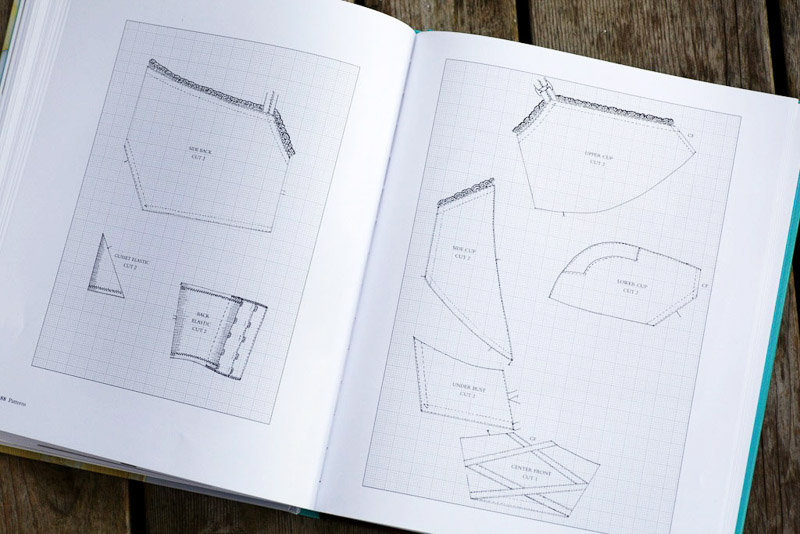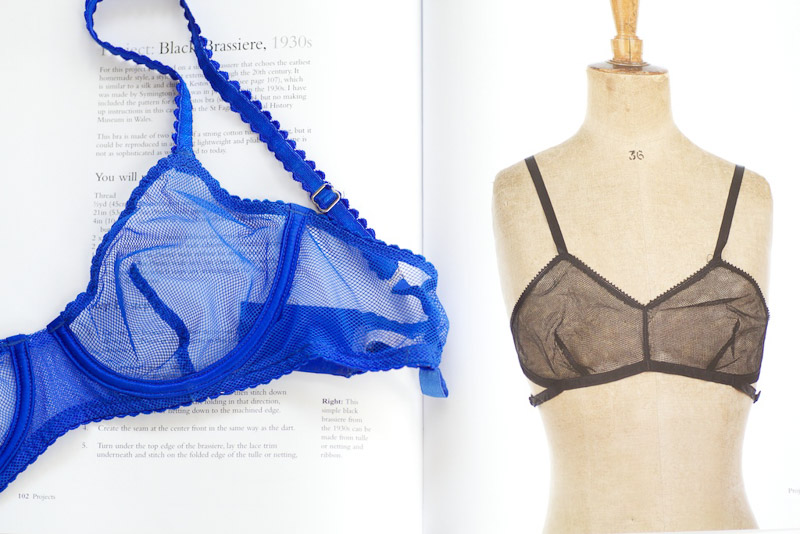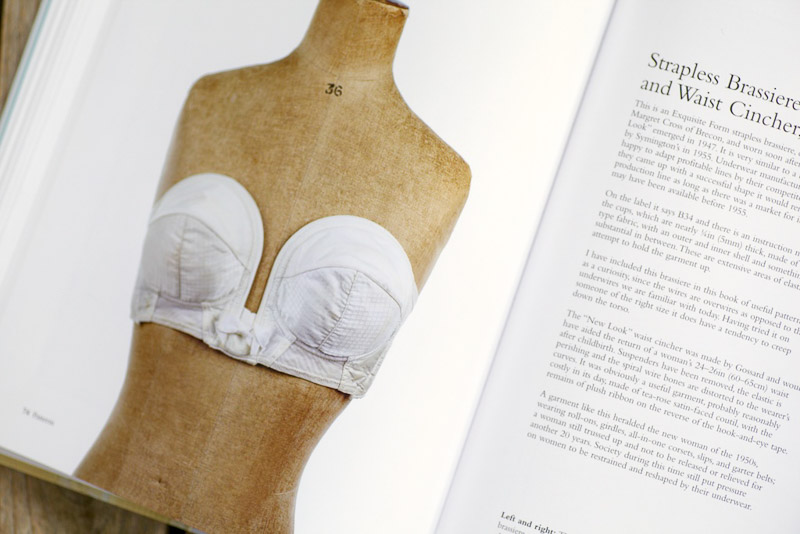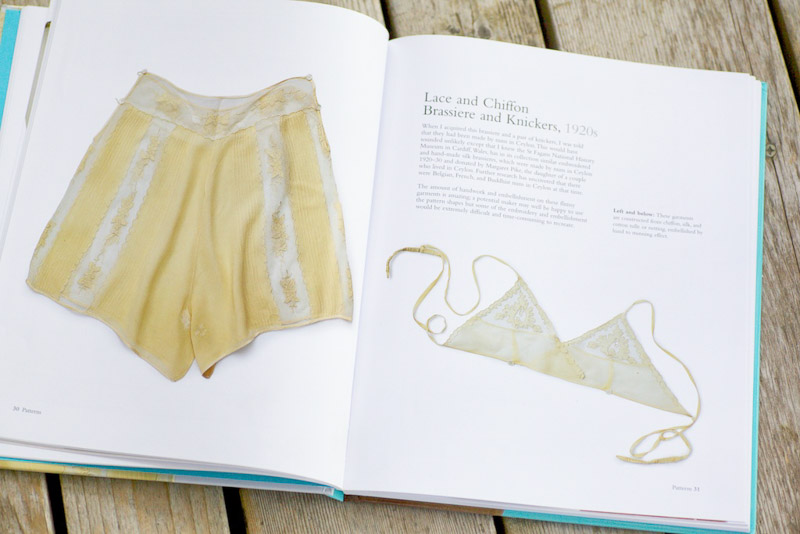
The history of lingerie and underwear is a fascinating subject, and I wanted at least one book that would give me a peek into the pretty underthings of the past. Corsetry, of course, remains its most popular subject and there is no end to the amazing resources for the beginning corsetiere or costumer. One of my favorite blogs is Bridges on the Body–I love her attention to period detail and and am in awe of the all the handwork that goes into making a corset. I don’t know if I’ll ever make one (but you never know!), but just watching the process of corsetry reminds me how much I love sewing as a savoring artistic process.
Still, I wanted something that ventured away from corsetry and was thrilled to discover this beautiful book, Vintage Lingerie by Jill Salen.
Salen is an English costumer who previously published a similar book on corsets. She wrote in her preface that she initially wanted this book to be about bras and brassieres exclusively but found that she couldn’t leave out all the other undergarments intended to be worn with them–the garter belts, girdles, knickers and slips. This is a hardback book with 30 examples of vintage pieces from her own collection. The garments mostly range from the 1920s to 1960s and are accompanied by scaled, gridded patterns detailing each piece.

The pattern pages themselves are rub-offs of each piece, marked on a grid that’s meant to be scaled up to one-inch squares. If you’ve ever worked with a Japanese pattern book, or something like the Betty Kirke Vionnet book, the pattern process will make sense. I’d say the value of these patterns is more in the experimentation than wearable garments–especially because they’re all just one size. However, the back of the book includes two start-to-finish projects–a black mesh bra (pictured below) and a waist slip–in which Salen walks you through scaling the patterns, cutting and sewing.
There is one post-50s corset but it is much closer to modern shapewear, because it’s made with elastic fabric. It’s obvious how quickly undergarment fashion shifted after spandex came on the scene–for instance, one doesn’t need garters to hold up stockings anymore. Did you know that spandex was an anagram of “expands”? DuPont invented spandex in the U.S. in 1959 and we usually know it as the DuPont/Invista brand name Lycra (outside of the U.S., its common name is elastane).
The comfortability, technical fiber science, and the “ideal” body silhouette may have changed, but it’s surprising how little some of the basic design has changed, especially among bras. This little black mesh bra from the 30s may not have comfortable spandex or underwires like my stretch mesh bra, but the pieces and design are virtually the same.

This early strapless bra from the 50s could be one of the celebrity plunge bras of today.

My favorite is the sweet little pale yellow silk bralette and French knicker set that’s featured on the cover.

And then there are these rather thick-looking high-waist knickers with a tummy panel. (We’re still doing that!)

I may not get around to the patterns but I can certainly learn from the details. All in all, it’s a very lovely book, full of amazing close-up photographs, that I think is a worthwhile addition to a sewing or fashion book library.
Would you like tips and inspiration in the craft of lingerie sewing? Sign up for my weekly eletter The Lingerie Maker.

Is the mesh bra pattern for that BE-YOU-TEE-FUL cobalt number? I was just thinking today that I really want/need/require a sheer black mesh bra. They look so enticing peeking out from an oversized tank, don’t they?
No, I bought the bra but it’s very similar! The 30s pattern is cute, isn’t it? Mine is super stretchy. I really wanted one in every color so I probably need to copy it! It’s so comfortable, and stretch mesh is really easy to find.
My grandmother was commenting on how lingerie has sort of shifted back to old school lingerie in the past few years or so. I guess the influx of spanx and shapers nowadays (and all that good stuff that holds you in!) is a throwback to the girdles of my grandma’s day. Then she told me about a type of girdle she used to wear when she was a young woman that was completely made out of latex. She said you had to powder yourself to get in to it and then you spent the day trying not sweat. I like reading about the history of lingerie, too. It’s fascinating!
Beautiful, beautiful things… sigh. Thank you for the peek into the book! It’s pretty interesting to look at our history through something as specific as women’s underwear – but it’s all in there, isn’t it? Politics, class, technology, psychology…
Wow! How gorgeous! I love all of these pieces!
what a great post Amy! I really enjoyed reading it! I almost bought that book but I instead opted for “Sewing Lingerie that Fits.” It’s definitely super interested about the history of the bra. I’m hoping that as I further my studies into this category of sewing, I’ll get more into corsets and such.
Could You please do more photos of the 30 things of witch we have the patterns in this book, i’m not sure if i will sew anothing of this book and its a little preecy?
Sorry for my english,
Xoxo from France,
by a polish girl :*
Hi Klara! I’m so sorry but I can’t add more photos. For a more affordable price you may want to see if there are any used copies? Amazon.co.uk sells it.